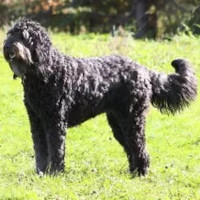Appearance of the Russian Doodle Terrier
|
| Big and bold is the best description of the Russian Doodle Terrier. Large and solid-bodied, they possess the athleticism and agility inherited from the Poodle. The body is well proportioned and has an elegant yet robust shape. The chest is fairly deep and the legs are sturdy but supple. The strong neck supports the wedge-shaped head, and the face can be bearded, a gift from the Russian Black Terrier parent. The muzzle is often long and pointed, with teeth that meet like scissors. Drooping ears and fluffy eyebrows make it hard to see where the eyes are, but then you notice the deep, round eyes of liquid amber that watch your every move. His face is curious and intelligent; he's one of the smartest dogs in the world, and he knows it. His coat envelops him like a dense, tousled suit, and can come in a variety of colors such as black, brown, cream, silver and white, to name but a few. The tail is often long and bushy, or may be docked. Strong, flowing, active and a real charmer, these seductive dogs are unique and rare, but worth seeking out if you have the time to devote to them. |
Temperament of the Russian Doodle Terrier
|
| Impressive in stature, solid yet fluid in movement, the Russian Doodle Terrier is a dog that is almost a contradiction in terms. They may seem formidable at first glance, especially if they have the facial and body characteristics of the black Russian Terrier relative - tall, massive and muscular. But their nature is the opposite: they are calm dogs, confident but not aggressive unless pushed, and affectionate and family-loving. Loyal and devoted, they make ideal companions and willing playmates. Full of energy and highly intelligent, this dog loves mental challenges such as training, field trials, agility or daily walks with you. They need human companionship and like to be included in family activities. Although he's a big, sturdy dog, he can adapt to life in an apartment, as long as he takes one or two daily walks to expend some of his energy. An active family will be a pleasure for this dog, as he's not the type to sit and snooze all his life. He wants action. Lots of action, so keep that in mind when looking for a new companion. His dense coat and curly fur require quite a bit of maintenance to keep him in tip-top shape, but it's well worth it when you see how beautiful this dog is to the touch. Like most dogs, Russian Doodle Terriers respond to positive reinforcement and praise when they learn something new. Brutal methods will not work with this dog and should not be used with any dog. He may be stubborn, but he's only testing you to see who's boss. The boss should be you, not the dog, otherwise you may end up with a demanding companion who tests your patience to the limit. Be the boss your dog wants you to be, in a fair and gentle way, and your hybrid will do whatever you want it to do. |
Needs and activities of the Russian Doodle Terrier
|
| Active and full of mischief, especially when they're young, Russian Doodle Terriers are big, active dogs who want to take part in everything that's going on around their home. They love human company and will do anything to become part of your life. They need regular daily walks to expend some of their accumulated energy, and make excellent walking or biking companions. Just keep them on a leash, as they have a strong hunting instinct and can get distracted by interesting trails or small, fast-moving animals. They love to play in water and thrive on mentally stimulating games or training. These dogs adapt very well to most climates and homes. They adapt best to a home with a yard they claim as their own, which they patrol to make sure no stranger enters unnoticed. Children will love a dog that just wants to play with them, and these dogs can play for hours. But when they're exhausted, they like nothing better than to curl up at your feet or as close to you as they can get. If you don't have the time to make sure your dog is well exercised and has constant company, he's not the dog for you. He needs to be with you, period. |
Maintenance of the Russian Doodle Terrier
|
| Your Russian Doodle Terrier's coat should be brushed every day or two to keep his dense, tousled coat looking its best. While grooming, check that your dog is in good health and has no cuts or lesions to heal. Dogs won't tell you if they're injured, they just persevere, so watch out for telltale signs of injury when you brush their coat. Their ears can be prone to infection as they are quite hairy, creating an ideal environment for bacteria to accumulate. Gently wipe the inside of the ear with a soft, damp cloth to clean it, then dry it carefully, taking care not to damage the delicate inner ear. Check the eyes to make sure they aren't weeping or that long hairs aren't creating a problem for the eyes. Prevention is always the easiest and most economical route to take when it comes to your dog's health. Bathing these big dogs is a real mission, but fortunately for you, they don't need it very often, unless they've stepped in mud or rolled in something nasty. Always use a dog shampoo that preserves their skin's natural oils and keeps their coat weather-resistant. Teeth and nails are next on the list: a quick trim of the nails is all that's needed, and brushing your Russian Doodle Terrier's teeth most of the time will help prevent any health problems and maintain good breath. |









 English (United Kingdom)
English (United Kingdom)